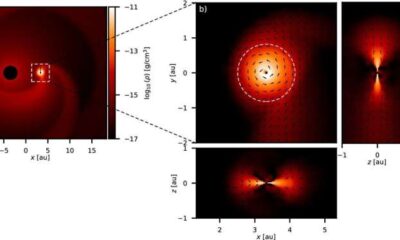Science
Researchers Uncover Mechanism Behind Venus Flytrap Sensitivity

The Venus flytrap, known scientifically as Dionaea muscipula, has captivated scientists and nature enthusiasts alike due to its unique method of capturing prey. A recent study led by Hiraku Suda and colleagues, published in Nature Communications, sheds light on the underlying mechanisms that enable this carnivorous plant to react swiftly to stimuli.
The research focuses on the plant’s sensory hairs, which are crucial for detecting potential prey. These hairs respond to movement through a mechanism involving calcium signals. While this concept has been previously established, the specific processes remained largely unexplained until now. The team identified a mechanosensor known as DmMSL10, which plays a vital role in the plant’s sensitivity.
Understanding the Mechanosensor
By creating a variant of the Venus flytrap that lacked the DmMSL10 channel, researchers were able to compare its response to that of the wild-type plant. Both variants activated calcium ion release when stimulated; however, the knockout variant exhibited a significantly reduced rate of action potential generation. The wild-type plant continued to produce action potentials even after the initial stimulation had ceased, highlighting the importance of DmMSL10 in detecting subtle movements.
In a follow-up experiment, ants were allowed to traverse the leaves of both the wild-type and knockout variants. The wild-type plant successfully captured the first ant that wandered onto its leaf, while the knockout variant remained unresponsive, failing to trigger the necessary calcium signals even after multiple attempts. This stark contrast emphasizes the role of DmMSL10 in prey detection, confirming it is essential for the plant’s rapid response.
Implications for Research and Evolution
The findings from this study provide a clearer understanding of how Dionaea muscipula and similar species, such as the waterwheel plant (Aldrovanda vesiculosa) and D. glanduligera, have evolved mechanisms to capture prey efficiently. The calcium signaling pathways identified could offer insights into how these plants, along with certain animal species, developed similar sensory systems over time.
Research in this area is expected to deepen our understanding of plant biology and the evolutionary processes that shape these fascinating adaptations. The implications of this work extend beyond the Venus flytrap, potentially informing studies on a wide range of organisms that rely on mechanosensation for survival.
As scientists continue to explore these complex biological systems, the Venus flytrap remains a subject of intrigue, revealing the remarkable capabilities of nature’s designs. The study by Suda and his team represents a significant step forward in unraveling the intricacies of plant responses to environmental stimuli, paving the way for future discoveries in the field of plant sciences.
-

 Science1 month ago
Science1 month agoOhio State Study Uncovers Brain Connectivity and Function Links
-

 Politics2 months ago
Politics2 months agoHamas Chief Stresses Disarmament Tied to Occupation’s End
-

 Science1 month ago
Science1 month agoUniversity of Hawaiʻi Joins $25.6M AI Project for Disaster Monitoring
-

 Entertainment1 month ago
Entertainment1 month agoMegan Thee Stallion Exposes Alleged Online Attack by Bots
-

 Science4 weeks ago
Science4 weeks agoALMA Discovers Companion Orbiting Giant Star π 1 Gruis
-

 Science2 months ago
Science2 months agoResearchers Challenge 200-Year-Old Physics Principle with Atomic Engines
-

 Entertainment1 month ago
Entertainment1 month agoPaloma Elsesser Shines at LA Event with Iconic Slicked-Back Bun
-

 World1 month ago
World1 month agoFDA Unveils Plan to Cut Drug Prices and Boost Biosimilars
-

 Business1 month ago
Business1 month agoMotley Fool Wealth Management Reduces Medtronic Holdings by 14.7%
-

 Top Stories2 months ago
Top Stories2 months agoFederal Agents Detain Driver in Addison; Protests Erupt Immediately
-

 Entertainment1 month ago
Entertainment1 month agoBeloved Artist and Community Leader Gloria Rosencrants Passes Away
-

 Science2 months ago
Science2 months agoInnovator Captures Light at 2 Billion Frames Per Second








